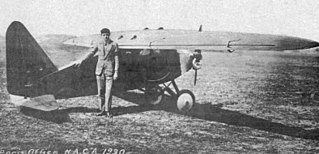
The RWD 2 was a 1929 Polish single-engine high-wing monoplane sports plane constructed by the RWD team.

Blériot Aéronautique was a French aircraft manufacturer founded by Louis Blériot. It also made a few motorcycles between 1921 and 1922 and cyclecars during the 1920s.

The Blériot 127 was a monoplane bomber aircraft developed and produced by the French aircraft manufacturer Blériot.
The Farman F.120 were a family of multi-engine monoplane aircraft designed and produced by the French aircraft manufacturer Farman Aviation Works. It was operated in a diverse range of purposes, including as a commercial airliner and as a military bomber aircraft.

The Mauboussin M.120 was a trainer and touring aircraft built in France in the 1930s and again in the years following World War II.

The Mauboussin M.200 was a French racing monoplane built by Fouga. It was a low-wing cantilever monoplane with a fixed tailskid landing gear. It had an enclosed cockpit for a pilot, and was powered by a Régnier 85.8 kW (115 hp) 4E.0 engine. It first flew on 21 March 1939, and in May 1939 established new FAI records for an aircraft of its class.

The Peyret-Mauboussin PM XI was a French high-wing touring aircraft of the early 1930s.
Avions Mauboussin is a French aircraft manufacturer created in the 1930s.
The Brown Aircraft Co was an American aircraft manufacturer of the 1930s and 1940s.

The Nieuport IV was a French-built sporting, training and reconnaissance monoplane of the early 1910s.
The Peyret Tandem or Peyret Alérion, was a French single seat glider of tandem wing configuration. It won first prize at the first British Glider Competition of 1922.

The Mauboussin M.40 Hémiptère was an experimental, single seat, single engine light aircraft with unequal span tandem wings, designed in France in the 1930s. Only one was built.

The Peyret-Mauboussin PM X, PM 4 or Mauboussin M.10 was a low power, single-seat, high wing cantilever monoplane. Only one was built but it set several records in the under 250 kg (550 lb) class both as a landplane and a floatplane.

Avions Kellner-Béchereau, known as Kellner-Béchereau, was a French aircraft manufacturer of the early 20th century.

The Mauboussin M.112, M-12 or Mauboussin M.XII was originally called the Peyret-Mauboussin PM XII and was renamed when Mauboussin founded his own company in 1931, ending his partnership with Louis Peyret. It was a French, single-engine, two-seat, low cantilever wing touring monoplane. At least six were built.

The Peyret-Nessler Libellule (Dragonfly) was a French two-seat, low-powered parasol wing light aircraft built in 1927 to provide practical but economical flying. It was one of the first of these French avionettes.












